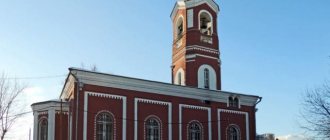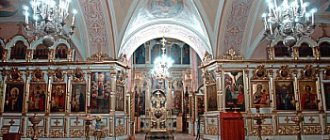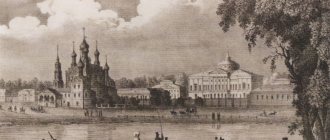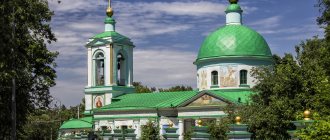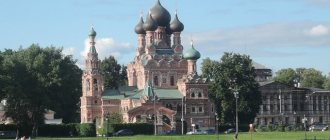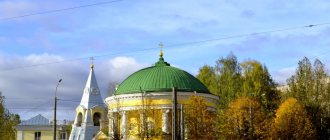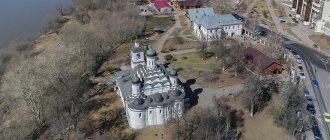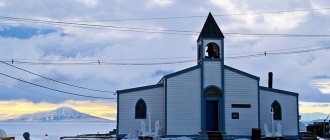Story
Konkovo is located in the South-West of Moscow. The first settlements in this territory date back to the 12th century. Later, several settlements existed in this area, but the largest of them were Troitskoye Konkovo and Sergievskoye Konkovo. In 1690 - 1694, the temple was built at the expense of the first chancellor of the Russian Empire, Gavrila Ivanovich Golovkin, the closest associate of Peter the Great.
Church of the Life-Giving Trinity in Konkovo
After this, the history of the Trinity Church in Konkovo developed as follows:
- The temple was built in the Naryshkin Baroque style and until 1772 it was a brownie with a main altar in honor of St. Sergius of Radonezh;
- after in 1772 the Church of the Holy Trinity in Konkovo became a parish church, combining two villages, Belyaevo-Dolnevo, Derevlevo, and at the same time the name of the temple changed;
- in 1808, a refectory was added to the temple, and the bell tower was increased by one tier;
- in 1812, the Church of the Life-Giving Trinity in Konkovo was destroyed by the French in 1812;
- the remains of the temple were dismantled and transferred for the construction of a bell tower, holy gates and a temple fence in the village. Sergievskoe;
- the further history of the church is very contradictory; according to sources, it is not clear when exactly the temple was restored, but nevertheless, in 1818 the church existed in the same place and in 1821 a stone fence was erected around it.
The last significant reconstructions that influenced the appearance of the Trinity Church in Konkovo were carried out in 1848, when, with the money of the Moscow merchant Ivan Baklanov, another chapel was built, consecrated in honor of St. Philip, Metropolitan of Moscow. During Soviet times, the temple operated until 1939, when it was closed; its further fate was as follows:
- until 1967 there was a state farm warehouse here;
- from 1967 to 1982, the warehouse of the Television Center, the latter refused the lease exactly this year, and the Church of the Life-Giving Trinity in Konkovo was empty for a long time, gradually collapsing.
In 1989, they decided to transfer the building of the former church to a scientific laboratory and for the first time, all communications were carried out. But Trinity Church was not destined to become a scientific institution; in 1991 it was returned to believers. Although services there resumed in 1990.
Important fact! It was in the first years after its closure that the temple was severely disfigured and lost its former appearance: the domes were dismantled, crosses were removed, the fence was dismantled, two tiers of the bell tower were destroyed.
More about Moscow churches:
- Church of the Life-Giving Trinity in Ostankino
- Resurrection Cathedral in Tutaevo
- St. Vladimir's Cathedral in Liski
Russian Orthodox Church
St. Andrew's Deanery of the Moscow City Diocese
The temple was built in 1690; initially its throne was consecrated in honor of St. Sergius of Radonezh. According to the church, the village of Serino, where the temple was located, began to be called Sergievsky.
The church was a manor church, built in the Naryshkin Baroque style. The manor buildings were wooden. In 1808, a warm refectory was added to the temple.
Initially, there was no parish at the Sergius Church. Until 1771, the church was a house church, and from 1772 it became a parish church, since two villages were assigned to it - Belyaevo-Dolneye and Derevlevo, which previously belonged to the Church of the Holy Trinity on Vorobyovy Gory. In 1803, after the abolition of the state clergy of the church. Konkovo, its parishioners were also assigned to the village of Sergievskoye.
In 1812, Trinity Church with. Konkovo was destroyed and then dismantled, building materials were used to build a bell tower, a fence with holy gates and a church gatehouse at the temple in the village. Sergievskoe. The utensils and land were also donated to the temple. Sergievskoe. In 1818, on the left side of the refectory church of St. Sergius, a chapel was built in honor of the position of the Robe of the Mother of God in Blachernae. The second chapel in honor of St. Philip, Metropolitan of Moscow, was established in 1848. In 1821, a brick fence was built around the church. On the southern side of the church, a two-story priest's house was built, in which a parish school was opened in 1880, and a primary zemstvo school was opened in 1884.
The temple was closed in the mid-1930s.
On February 28, 1990, the Cheryomushkinsky District Executive Committee of Moscow decided to transfer the church building in Konkovo to the Orthodox community. On December 24, 1990, the Moscow City Executive Committee terminated the lease agreement with the Institute of Earth Physics and adopted a resolution to vacate the church building. A warrant to occupy the premises was issued on January 14, 1991.
Divine services were resumed in April 1991. The main altar was consecrated in 1991 in honor of the Life-Giving Trinity. In 1996, an additional altar was built in honor of St. Sergius of Radonezh.
By 1998, the second tier of the bell tower was restored and a full rank of bells was installed on it. Gilded crosses were installed on the main temple, altar and bell tower. By the spring of 1999, a clergy house was built with a refectory, an office, utility rooms and basements for storing church utensils. In 2000, the whitewashing was completed and the decoration of the altar was renewed. By 2004, facade and roofing work was completely completed. A complex of parish buildings with an attached baptismal church was built in honor of the Epiphany of the Lord.
By order of His Holiness Patriarch Kirill of Moscow and All Rus' dated April 12, 2022, a Representation of the Chisinau-Moldovan Metropolis was established at the Church of the Life-Giving Trinity in Konkovo, which previously operated at the Church of the Entry into the Temple of the Blessed Virgin Mary in Barashi in Moscow. Metropolitan Vladimir of Chisinau and All Moldova was appointed rector of the Trinity Church in Konkovo.
Current state
After the return of the temple, it was quickly restored - the bell tower was rebuilt, domes were erected, and a beautiful iconostasis was installed.
Iconostasis of the Church of the Life-Giving Trinity
In terms of its architecture, the temple belongs to the style called “Naryshkino Baroque”, and it is characterized by the following features:
- patterned external design;
- a mixture of different styles (Baroque, Gothic, Mannerism and others);
- excessive detailing of various elements of the building;
- traditional Russian floral ornament made in baroque style.
All these moments of the “Naryshkin baroque” are also present in the appearance of the church.
Activities of the parish
Like any Moscow church located in the center of a microdistrict, the clergy of the Konkovo parish is not limited to divine services, but also organizes various other types of work aimed at educational and social-charitable activities.
- There is a Sunday school for both children and adults.
- A parish library has been opened, which is regularly replenished, including through donations from parishioners.
- Conversations are held every week.
Parishioners also visit a nursing home, a boarding school for mentally retarded children and an orphanage.
Patronal holidays
The main altar is consecrated in honor of the Holy Trinity, the celebration takes place on the 50th day after Easter. There are two more chapels:
- St. Sergius of Radonezh, October 8th is the day of the saint’s death, and July 18th the day of the discovery of his relics;
- position of the Robe of the Mother of God in Blachernae, this is the outer garment of the Mother of God, which she gave to one girl shortly before her Assumption, in the family of this girl the chasuble was kept until the 5th century, until it was found and placed in the Blachernae Church of the Mother of God in Constantinople, the feast of the placement of the Robe celebrated on July 15th.
Divine service at Trinity Church
The holiday itself is directly connected with Russia. In 860, a huge army of Rus, led by Askold, besieged Constantinople. The then Patriarch of Constantinople, Photius, walked around the walls of the city in a religious procession and lowered its edge into the waters of the Bosphorus Bay. After this, a miracle happened - the Russians lifted the siege and peace negotiations began, as a result of which Askold and his brother Dir, as well as part of their squad, accepted Baptism, which was called the First or Photius.
Church of the Life-Giving Trinity
The Church of the Holy Life-Giving Trinity in Konkovo is located in the Southwestern region of Moscow, included within the city in 1960. Previously, the village of Konkovo was in the Sosensky camp of the Moscow district, 14 versts from Moscow along the Old (Bolshaya) Kaluga Road. The temple was called Sergievsky, and only in 1991, during its renewal, was it consecrated in the name of the Holy Trinity.
In the 12th century on the site of modern Konkov there was a Slavic settlement.
In the 17th century On the sides of the Old Kaluga Road there were two villages - Konkovo-Sergievskoye (Serino) and Konkovo-Troitskoye, and each of them had its own church. In the first - in the name of St. Sergius, the Wonderworker of Radonezh, and in the second - in honor of the Life-Giving Trinity.
The earliest known owner of Sergievsky, which at that time was called the village of Serino “on the enemy,” was the boyar Pyotr Nikitich Sheremetev, appointed governor of rebellious Pskov in 1606. There, in the fall of 1609, he was strangled in prison. In 1619-1620 the village of Serino was granted to the steward Fedor and Dmitry Mikhailovich Tolochanov. According to the inventory carried out in 1621-1627, in the village there was “a courtyard of landowners, and in the courtyard live the clerk Romashka Grigoriev and business people Osipko Stepanov and Mishka Afonasyev.” Since 1652, only F.M. Tolochanov remained the owner of the estate. His son, Semyon Fedorovich Tolochanov, in 1690, built the current church, consecrated in the name of St. Sergius of Radonezh. The village began to be called Sergievsky after the church.
There is an entry about this in the incoming salary book of the Patriarchal Treasury Order, stored in the Moscow Archives of the Ministry of Justice: “last May 7198, on the 21st day, by decree of the Great Sovereigns <John and Peter> and according to the note on the extract of Andrei Denisovich Vladykin, it was ordered the newly built church of St. Sergius of Radonezh the Wonderworker, which was built by the okolnichy Semyon Fedorovich Tolochanov in the Moscow district, in the Sosensky camp, in his patrimony, in the village of Serin, to put tribute on the priest from the clergy, according to the specified article, from the priest’s households 4 money, deacon and mallow milk on the money , from votchinnikov 6 money, from 20 households of business people, money from the yard, and from memory from the Local Prikaz, with the signature of clerk Anisim Nevezhin, which was sent to the Kamenny Prikaz, about a certificate to that church from church land, from 10 quarters, 3 money from a quarter, from 10 kopecks of hay, 2 money per hay, the total tribute is 13 alt. 1 day Check-in hryvnia. And in the current year 7202 (1694), by decree of the patriarch and according to an extract from the treasurer, Elder Paisius Siiskago, it was ordered to take this money from that church from 7202 (1694). And on the 20th day of February, the given money for the current year 7202 (1694) was taken; Joseph Yakovlev, a protege to the priesthood, paid to that church, and Ivashko Neustroev accepted it.”
The church was an estate church, built in the “Naryshkin Baroque” style, characterized by an abundance of decorativeness, pomp and grandeur. It included a small quadrangle of the temple, bearing an octagon and a dome on a drum; in the northeast there was a rectangular altar, and, as experts believe, there was the same rectangular porch on the opposite side. There was no refectory; There was no special bell tower, and the bells hung on the western wall of the church. Inside the wall there were choirs and on them on the western side a window from which the bell was made; in addition, there was a stone staircase to the choir. The temple was placed with an altar in the northeast, on the Trinity-Sergius Lavra - the place of the works and exploits of St. Sergius, where his relics rest. According to legend, the Reverend visited the place where the village of Serino was located and consecrated it with his prayers, wanting to found a monastery here. But according to a revelation from above that there would be a lot of people here, he went to Mount Mokovets.
Manor buildings at this time and later were wooden. In 1808, a warm refectory was added to the temple.
Subsequently, the village belonged to the granddaughter of Semyon Tolochanov, Princess Nastasya Vasilyevna Golitsyna, whose husband, Prince Sergei Alekseevich Golitsyn, was the Moscow governor under Empress Elizabeth Petrovna. Later the estate passed to their children.
Initially, there was no parish at the Sergius Church. Until 1771, the church was called a house church, and from 1772 it became a parish church, since two villages were assigned to it - Belyaevo-Dolneye and Derevlevo, which previously belonged to the Church of the Holy Trinity, on the Sparrow Hills. Due to the remoteness and inconvenient communication, the parishioners of these villages asked the Moscow diocesan authorities to assign them to the church in the village of Sergievskoye.
The population of the village of Sergievskoye in 1790 consisted of the courtyard people of the landowner Colonel Fyodor Ivanovich Boborykin, a total of 29 people in one yard, and three church courtyards. The parish included 19 courtyards in the village of Belyaevo and 20 courtyards in the village of Derevlevo, a total of 116 male souls and 142 female souls.
In 1803, after the abolition of the state clergy of the church. Konkova, her parishioners were also assigned to the village of Sergievskoye. According to the Economic Notes of 1769 of the Moscow district, number 248 states: “the village of Konkovo is the property of Her Imperial Majesty: 13 households, 101 male souls. Stone church in honor of the Holy Life-Giving Trinity. The house is made of stone with services, a formal garden and a menagerie.” This estate was purchased by Empress Catherine as a result of the request of the peasants and their complaints about the cruel treatment of them by the landowner, and, in memory of their liberation, a stone obelisk was erected in the village of Konkovo, which was installed on the very spot where the Empress accepted the petition of the peasants. (The white stone obelisk stood until 1972, then moved to the Museum of Architecture in the Donskoy Monastery).
In the difficult time of 1812, Trinity Church. Konkova was destroyed by the French retreating along the old Kaluga road and, due to the impossibility of amendment, in 1813, with the permission of the Moscow Diocesan authorities, it was dismantled to the ground; the remaining material from the Trinity Church was used to build a bell tower, a fence with holy gates and a church gatehouse at the church in the village of Sergievsky. The utensils and land were also transferred to the temple of the village of Sergievsky.
In 1818, through the zeal of the landowner Alexei Fedorovich Ladyzhensky, on the left side of the refectory church of St. Sergius of Radonezh, a chapel was built in honor of the position of the Venerable Robe of the Mother of God in Blachernae; Before the refectory was built, the landowner's parents were buried in this place. The second chapel in the name of St. Philip, Metropolitan of Moscow, was built in 1848 at the expense of the Moscow merchant Ivan Filippovich Baklanov.
From the inventory of the month of October 1813 of the property of the church in the village of Sergievsky, it is clear that in 1813 there was a stone bell tower, on which there were 5 bells, of which the large one weighed 25 pounds, the 2nd weighed 4 1/2, and the others were smaller than each other. . From the same inventory it is clear that until 1842 the donors for the temple and its decoration were: Elena Aleksandrovna Solekhenova, Ivan Mikhailovich Bonakov, Stepanida Fedorovna Anisimova, Pavel Nikolaev, Moscow merchant Maremyana Vasilievna Zhiltsova. In 1821, a brick fence was built around the church.
There was 1 dessiatine of land at the church. 1150 sq. soot., arable 28 des. 1098 sq. soot., mowing 2052 sq. sazh., under a birch grove 2 des. 400 sq. sazh., and in the same birch grove under the cemetery 1 des. 50 sq. s., under Bolshaya Kaluga Road 1160 sq. soot., under the half-source 780 sq. sazh., and the total of convenient and inconvenient land is 33 dessiatines. 1940 sq. sazh., excluding inconvenient places of convenient land, 31 dessiatinas remain. 1150 sq. soot The famous historian I. Tokmakov clarifies that as of 1893, “the clergy’s own wooden houses were built on church land. Parish of the church Sergievskoye consists of parishioners of the said village (i.e. Sergievsky-Konkov) and the villages: Dolnee-Belyaevo, Derevlevo, Brekhovo (Bryukhovo), contains 159 courtyards, 439 souls, 454 women. p. <…> Among the shrines especially locally revered is the icon of St. Sergius, on which in the ark there is part of the relics of the mentioned saint, placed on those praying during prayer singing.” As the same I. Tokmakov notes: “In 1830, 1847, 1848, the cholera years, the disease mercilessly destroyed people. And in the parish of the church of St. Sergius of Radonezh there were only 3 people who died. Since then, in memory of the deliverance and preservation of the inhabitants from misfortune, annually the parishioners performed a prayer service to the locally revered image of St. Sergius of Radonezh not only in the squares, but also in the houses of parishioners. The icon of St. Petersburg was especially revered. Sergius by the inhabitants of those villages where cholera raged cruelly.”
In 1895, the owner of the estate was Lieutenant General N.F. Ladyzhensky. The last owners of the estate were the hereditary honorary citizens Iroshnikovs.
A colorful description of Sergievsky at the end of the 19th century. left by historian D.O. Shepping: “On the right side of the high road, opposite the Konkovsky courtyards, there is a birch grove on an elevated place with properly planted alleys, which probably belonged to Count Vorontsov’s park; Now part of it has been turned into a village cemetery. In the middle of the grove there is a large mound, and on the other side, on the slope of a large ravine, there are many low prehistoric mounds... In this grove there is a folk festival on July 5th. Next comes the estate, now of the merchant Iroshnikov, and the Church of Sergius with church houses, but without peasant estates. Traces of French bullets from 1812 are still visible on the walls and doors of the church.”
Sergievskoye and Konkovo were famous for their apple and cherry orchards, “very rarely, as the same D. O. Shepping wrote, found in such abundance among our peasants near Moscow; and probably owe their origin to the former lordly gardens.”
In 1928 the temple was still operational. Unique photographs dating back to 1935 captured the appearance of the temple shortly before its closure. In addition to the temple itself, the photographs show a two-story priest's house standing next to the south side, in which a parish school was opened in 1880, and a primary zemstvo school in 1884, the trustee of which was the owner of the village. Narrow Prince P.N. Trubetskoy.
In the first years of Soviet power, the fate of the temple became similar to the fate of most churches: destruction, confiscation of valuables, desecration.
During these bitter times of atheism for our Fatherland, 28 items of church utensils were removed from the church: three crosses (large, medium and small), a monstrance, paten, spoons, stars, bowls, etc.
In 1939 the temple was closed. Its appearance was completely disfigured: the upper two tiers of the bell tower were destroyed, the dome with the cross and the fence were dismantled. Bells, church utensils, icons and Holy books were removed. The temple building was used as a state farm warehouse; the Konkovo state farm office was located in the priest's house.
In 1960, the temple was included in the state lists of architectural monuments as a monument of the 17th century of federal significance under No. 402: “Trinity Church in Konkovo.”
In 1967-1972 Inside the temple there was a warehouse for the Television and Technical Center.
In 1972-1973 The church was examined by specialists from the All-Union Production Research and Restoration Plant of the USSR Ministry of Culture, at the same time a restoration project was completed (the main architect of the project is S. Kravchenko) and restoration work began.
In 1982, the Television Center refused to lease the temple building and was released from responsibility for the safety of this monument, which was assigned to the regional authorities.
For a long time, the district authorities did nothing to preserve the church building, the destruction of which continued. In 1989, the temple was going to be transferred to the laboratory of the Institute of Physics of the Earth, which had already begun restoration, based on considerations of adapting the building for its purposes. At this time, all communications were carried out to the temple.
In 1991, the temple was returned to believers.
Talking about the history of the Church of the Life-Giving Trinity in Konkovo, one cannot fail to mention those clergy whose painstaking and selfless work built up the parish for more than two centuries, whose prayerful feat attracted pious donors, those who brought the light of the Gospel truth to the residents of the surrounding villages, who worked in the field public education, spiritually supported his flock in difficult years for our Fatherland.
The first protege to the priesthood of the Church of St. Sergius of Radonezh the Wonderworker from 1694 to 1717. there was, according to the parish and census books of the Moscow district, a priest Joseph Yakovlev. Had sons John (also a Sergius priest from 1717 to 1756); John the Younger and Timothy (deacon of the church of St. Sergius). Died in 1717
According to the same parish and census books, in these same years Gabriel Evtikheev served as a priest of the Sergius Church.
On March 20, 1717, the passing memory of the signature of the petition by His Grace Metropolitan Stefan of Ryazan and Murom to the Sergius Church in the place of his deceased father was given to John Joseph.
Initially, in 1716, John Josephov was ordained as a priest to the Church of the Kazan Most Holy Theotokos, in the village of Bogorodskoye-Voronino, Moscow district of Pekhryanskaya tithe, in the patrimony of Prince I.A. Golitsyn. His Eminence Alexy, Bishop of Sarsk and Podolsk, gave him a priestly letter signed by His Eminence Stefan, Metropolitan of Ryazan and Murom.
In 1728, Father John was widowed. On April 27, 1733, he received the third Epitrachelion memory for three years at the request of Prince S.A. Golitsyn.
On August 14, 1739, he was given the Epitrachelion memorial for six years at the request of Prince S.A. Golitsyn. In 1756, priest John Josephov was tonsured at the Moscow Znamensky Monastery.
During these same years (1717-1756), the priest’s brother Timofey Osipov served as a deacon of the Sergius Church.
From 1756 to 1771 The rector of the temple was priest Vasily Ivanov, who had previously been the sexton of the upper Church of the Savior of the Image Not Made by Hands in the village. Pokrovskoe (Fili) Zagorodskaya tithe. On March 18, 1756, dedicated by His Grace Philemon, Bishop of Georgia, at the request of the Privy Councilor and Moscow Governor, Prince S.A. Golitsyn. He corrected the requirements at the request of the peasants of the villages of Derevlevo and Belyaevo, who were in the parish of the village of Vorobyov, Zagorodskaya Tithe, and the palace Kolomenskaya volost. Died with his wife November 14, 1771.
On March 6, 1772, Ioann Alekseev, the son of the deacon of the Kazan Church in the village of Bogorodsky, Pekhryansk tithe, Alexei Timofeev, was appointed priest to the Sergievskaya Church. On June 19, 1765, he was appointed sexton of the Sergius Church: he was dedicated to the surplice by a member of the Synod, His Eminence Timothy, Metropolitan of Moscow. In 1772, His Grace Metropolitan Nicholas of Georgia promoted him to deacon on February 16 in the parish of the Church of the Resurrection of Christ in Kadashi; ordained as a priest - February 15 in the Church of the Savior of the Image Not Made by Hands in the village of Spassky (Katovo), Moscow district of Seletskaya Tithe. He was married to the daughter of priest Vasily Ivanov, Marya, and the orphaned daughters of priest Vasily Ivanov were in his care.
From 1781 to 1792 Alexey Petrov served as the priest of the church in the village of Sergievsky. In the Clergy Gazette of 1785 there is an entry: “Priest Alexei Petrov is 31 years old, has not studied at school, has a literacy, is good at reading and singing, married, in good condition.” In 1792 he left for the Church of the Savior on Prechistenka. Died 1799
From 1792 to 1842 Archpriest Dimitry Yakovlev Vozdvizhensky served in the Sergius Church. His parents were the priest Yakov Ivanov and Aksinya Yakovleva, the daughter of a priest. After completing several classes, he studied at Trinity Seminary: poetry, rhetoric, philosophy, theology and languages: Latin, French and German. In 1791 he graduated from the theological course at the Lavra Seminary. On February 1, 1792, he was ordained a priest at the Church of the Transfiguration in the village of Savina, Vokhonsky Tithe. On October 21, 1792, he was transferred to the Church of St. Sergius in the village of Sergius, Moscow district, and was appointed deputy. On December 17, 1796 he was approved as dean. In 1812-1813, after the invasion of Napoleonic troops, he consecrated the following churches: Borisoglebskaya in the village of Zyuzino, Nikolaevskaya in Kotly, Nikolaevskaya in the village of Saburovo, Kazanskaya in the village of Kolomenskoye, Trinity in Teply Stany, Znamenskaya in Sadki, the Life-Giving Spring of the Blessed Virgin Mary in the village Tsaritsyno, Troitskaya in the village of Cheryomushki, Kazanskaya and the chapel of John the Baptist in the village of Bogorodskoye (Uzkoye).
In 1830, during the raging cholera in Moscow, he sent the priests of the Sergiev deanery: A.I. Sinaisky to correct the requirements in the hospitals of the Riga and Tula infantry regiments due to the non-existence of a regimental priest during the entire continuation of the cordon of the capital, S.I. Maksimovsky - for parting words in a temporary hospital established in the village of Kizhunova at the observation outpost above the water communication. He presented reports to the deanery about children born who were vaccinated with smallpox in the second half of 1830.
On January 16, 1834, he was promoted to archpriest by order of His Eminence Philaret Metropolitan of Moscow by His Eminence Nikolai Vicar of Moscow for long-term holding of the deanery position in the Intercession chapel of the Church of the Life-Giving Trinity in Zubov Prechistensky forty.
He had insignia: a bronze Cross in memory of 1812, a purple skufia (January 20, 1827). Of his 14 children born, four died in infancy. Three of his sons accepted the priesthood.
In May 1842 he was dismissed from the staff. He died on April 10, 1843 at the age of 72 and was buried by the spiritual father of the Znamensky Monastery, Hieromonk Jonah, in a designated cemetery.
In 1843, the priest John Ioannov Zercheninov took over the rectorship of the Sergius Church. He was born in Moscow on January 4, 1818. His father, John Gavrilov, was the sexton of the St. Nicholas Church of the Prechistensky Forty, his mother, Natalya Timofeeva, was the daughter of the sexton of the St. Nicholas Church in Vagankovo of the Nikitsky Forty. The future priest studied at the Spasso-Androniyevsky district school. Then he studied at the Moscow Seminary in the sciences: theological, philosophical, rhetorical, historical, mathematical; languages: Latin, Greek, German and Hebrew. After completing the course of science in 1840, he was graduated with a 2nd category certificate. Promoted to the priesthood of the Sergius Church by His Eminence Philaret, Metropolitan of Moscow on February 26, 1842, consecrated by His Eminence Vitaly, Bishop of Dmitrov on May 21, 1842. The diploma was given after the signature of His Eminence Philaret, Metropolitan of Moscow.
On April 15, 1860, he opened a school at the church, in which the children of parish peasants (34 boys) who were in the appanage department were taught free of charge: reading, writing, the Law of God, arithmetic and musical singing. In 1873, the school was closed due to the publication by the Moscow District School Council of a new program that was unsuitable for rural parish priests as teachers. He was the confessor of the deanery from 1865 to 1889.
In 1873, at the request of His Eminence Innocent, Metropolitan of Moscow and Kolomna, he received permission to cut 12 fathoms of firewood from the church forest every year for heating his houses. This forest was grown “by the diligence of the real parish priest, Father Zercheninov, and was preserved by his care and vigilant protection from kidnappings during the 31st year of his priesthood.”
In January-February 1887, based on his information, a church metric was compiled for the Imperial Archaeological Society. Died June 7, 1889 from paralysis.
In 1889, the priest of the temple, St. Sergius was appointed Archpriest Gabriel Shumov, the son of a priest of the Baptist Church in the village. Yarogulcha Volokolamsk district Fedot Georgiev.
He graduated from the course of study at the Bethany Theological Seminary in 1860 in the 2nd category. In 1861, His Eminence Metropolitan Philaret appointed him a priest to the Church of the Intercession in the village of Osheinika, Volokolamsk district.
In 1889, His Eminence Metropolitan Ioannikiy transferred to the village of Konkovo, Moscow district. He served as a law teacher at the Osheininsky zemstvo school from 1874, and from 1889 at the Konkovsky school. Awarded for service: in 1872 - for public education - 25 rubles, in 1874 - with the blessing of the Holy Synod; in 1874 - a leg guard; in 1885 - skufya; in 1886 - Order of St. Anna, 3rd class. On September 11, 1893, he was presented to the kamilavka by the dean, since “he worked a lot on the renewal and decoration of the parish church and on the path of public education.” In May 1898 he was promoted to archpriest.
On July 26, 1911, parishioners of the village of Sergievsky-Konkov, Moscow district, with the permission of His Eminence, solemnly honored their pastor, Fr. Archpriest G.F. Shumov on the occasion of his fiftieth anniversary of service in the priesthood. Priest of the Moscow Archdeacon Stefanovskaya, at the Noble Almshouse, Church of N.G. Shumov spoke a deeply felt word about the many difficulties of pastoral service in general, and in our villages in particular, and at the same time mentioned the merits of the hero of the day for the parish.
Church warden - landowner M.N. Iroshnikov presented the hero of the day with a holy icon depicting St. Sergius, built at his own expense and collected from parishioners, in an expensive silver-gilded robe, with a respectful request to accept it as a sign of gratitude of the spiritual children for the zealous, reverent service of the hero of the day at the Throne of God in their parish church.
In August 1912, he was dismissed from the staff. Sons: Sergei, Archpriest of the Moscow Mother of God, which is at the Haas hospital, the Church of the Ivanovo Forty; Nikolai, priest of the Moscow Archdeacon Stefanovskaya, at the Noble Almshouse, church; Vasily, Sergievsky priest (since 1912). Gabriel Shumov died on March 3, 1914 at the age of 78, and was buried near the church.
The last rector of the church before its closure was the son of Sergievsky Archpriest Gabriel Shumov, priest Vasily Shumov.
He graduated from the Bethany Theological Seminary in 1901. From January 1902 he was a teacher at the Poltev parish school, from September 1, 1902 to May 1903, he was a teacher at the Erin parochial school in Podolsk district.
On May 28, 1903, His Eminence Vladimir Metropolitan of Moscow appointed him a priest to the Trinity, village of Eldigina, church in Dmitrovsky district. July 12, 1912 His Eminence Vladimir Metropolitan of Moscow transferred to the Sergius Church.
Awarded: on May 6, 1910, with a nabedrennik - for zealous teaching of the Law of God, on May 6, 1915, with a purple skufiya - for diligent and useful service for the church; for Easter 1918 with kamilavka; in 1921 with a pectoral cross.
In 1927, his sons took part in the work of the Konkovskaya Agricultural Bakery.

